Broan BUEZ3 Handleiding
Bekijk gratis de handleiding van Broan BUEZ3 (12 pagina’s), behorend tot de categorie Afzuigkap. Deze gids werd als nuttig beoordeeld door 52 mensen en kreeg gemiddeld 4.7 sterren uit 26.5 reviews. Heb je een vraag over Broan BUEZ3 of wil je andere gebruikers van dit product iets vragen? Stel een vraag
Pagina 1/12

BUEZ3 SERIES
RANGE HOOD
READ AND SAVE THESE INSTRUCTIONS
WARNING
TO REDUCE THE RISK OF FIRE, ELECTRIC SHOCK, OR INJURY
TO PERSONS, OBSERVE THE FOLLOWING:
1. Use this unit only in the manner intended by the manufacturer. If
you have questions, contact the manufacturer at the address or
telephone number listed in the warranty.
2. Before servicing or cleaning unit, switch power off at service panel
and lock service panel to prevent power from being switched on
accidentally. When the service disconnecting means cannot be
locked, securely fasten a prominent warning device, such as a
tag, to the service panel.
3. Installation work and electrical wiring must be done by a qualified
person(s) in accordance with all applicable codes and standards.
4. Sufficient air is needed for proper combustion and exhausting of
gases through the flue (chimney) of fuel burning equipment to
prevent backdrafting. Follow the heating equipment manufacturer’s
guideline and safety standards such as those published by the
National Fire Protection Association (NFPA), and the American
Society for Heating, Refrigeration and Air Conditioning Engineers
(ASHRAE), and the local code authorities.
5. When cutting or drilling into wall or ceiling, do not damage electrical
wiring and other hidden utilities.
6. Ducted fans must always be vented to the outdoors.
7. Do not use this unit with any solid-state speed control device.
8. To reduce the risk of fire, use only metal ductwork.
9. Use with approved cord-connection kit only.
10.This unit must be grounded.
TO REDUCE THE RISK OF A RANGE TOP GREASE FIRE:
1. Never leave surface units unattended at high settings. Boilovers
cause smoking and greasy spillovers that may ignite. Heat oils
slowly on low or medium settings.
2. Always turn hood ON when cooking at high heat or when cooking
flaming foods.
3. Clean ventilating fans frequently. Grease should not be allowed
to accumulate on fan or filter.
4. Use proper pan size. Always use cookware appropriate for the
size of the surface element.
TO REDUCE THE RISK OF INJURY TO PERSONS IN THE EVENT
OF A RANGE TOP GREASE FIRE, OBSERVE THE FOLLOWING:*
1. SMOTHER FLAMES with a close-fitting lid, cookie sheet, or metal
tray, then turn off the burner. BE CAREFUL TO PREVENT BURNS.
If the flames do not go out immediately, EVACUATE AND CALL
THE FIRE DEPARTMENT.
2. NEVER PICK UP A FLAMING PAN - You may be burned.
3. DO NOT USE WATER, including wet dishcloths or towels - a violent
steam explosion will result.
4. Use an extinguisher ONLY if:
A. You know you have a Class ABC extinguisher and you already
know how to operate it.
B. The fire is small and contained in the area where it started.
C. The fire department is being called.
D. You can fight the fire with your back to an exit.
*Based on “Kitchen Firesafety Tips” published by NFPA.
CAUTION
1. For indoor use only.
2. For general ventilating use only. Do not use to exhaust hazardous
or explosive materials and vapors.
3. To avoid motor bearing damage and noisy and/or unbalanced
impellers, keep drywall spray, construction dust, etc. off power unit.
4. For best capture of cooking impurities, your range hood should
be mounted 20-25” above the cooking surface.
5. Please read specification label on product for further information
and requirements.
IMPORTANT: OBSERVE ALL GOVERNING CODES AND
ORDINANCES
Your range hood has been designed to filter out smoke, odors, and
grease which rise from the cooking surface. Before you begin the
installation be sure that all parts and accessories are removed from
carton. For best results and ease in the installation of this range hood,
read the instructions sheet to become familiar with the step-by-step
installation.
TOOLS AND MATERIALS REQUIRED
Drill, electric or ratchet drive
1/8" drill bit for drilling pilot holes
7/64" drill bit to drill holes for EZ1 brackets mounting screws
1-1/4" wood bit for drilling electrical wiring access hole
One common head screwdriver for securing hood mounting screws
to the cabinet and hood sheet metal parts
Pliers for opening knockouts
Pencil, rule and level for marking cabinet locations
Saber saw or keyhole saw for cutting the wall or cabinet openings
Metal snips, duct tape, duct (with elbows and transition, if
necessary), roof cement or caulk, and roof or wall cap, as required
Electrical wiring and supplies of type to comply with local codes
The following materials are required only for installation on recessed
bottom kitchen cabinets:
Two 1" x 2" x 12" (approximate length) wood strips (purchase
locally)
Four 1-1/4" long flat head wood screws (purchase locally)
INSTALLER:
LEAVE THIS MANUAL WITH THE HOMEOWNER.
HOMEOWNER:
USE AND CARE INSTRUCTIONS ON PAGE 5.
!
INTENDED FOR DOMESTIC COOKING ONLY
!
Register this product at
www.broan.com/register.
To order Service Parts: go to www.broan.com

2
LIGHT LENS
ALUMINUM OR
COMBINATION
FILTER
JUNCTION BOX
PREPARING THE HOOD
1. Unpack hood and check contents. You should receive:
1 – Filter with built-in light lens
1 – 3-1/4" x 10" damper/duct connector
1 – Installation parts bag, located inside junction box
2. Remove junction box cover, EZ1 brackets and parts bag from inside
junction box.
3. Remove top or rear electrical knockout. Install an appropriate strain
relief.
4. Select one of the three types of venting available:
Non-Vented — Remove vent
cover from hood front. Replace
the aluminum filter with a non-
ducted filter (BP57 or R610050
- purchase separately). Go
to "Preparing the Installation
Location".
Rectangular Vented — 3-1/4" x 10" vertical or horizontal. Remove
knockout for vertical or knockout for horizontal venting. Install
damper/duct connector over opening. Go to "Planning Ductwork
Installation".
Round Vented — 7" vertical. Remove knockouts and exposing
duct collar. Go to "Planning Ductwork Installation".
PLANNING DUCTWORK
INSTALLATION
This section is for vented hoods only. For non-vented hoods, skip
this section and go to "Preparing the Installation Location".
Begin planning ductwork by deciding where duct will run between hood
and outside. For best performance, use shortest possible duct run and a
minimum number of elbows. There are several choices.
Ducting directly through the wall (for range hoods mounted on an
exterior wall). Shown are two ways to duct through an outside wall. If a
wall cap is used directly off the back of the hood, special care must be
taken to make sure that the damper in the damper/duct connector on
the hood and damper in the wall cap do not interfere with each other
when the hood is operating. This could result in either inadequate air
delivery or back drafts. If this condition does exist, remove the hood
damper flap. Sometimes when using a wall cap, it is easier to duct
vertically and then use an elbow.
Ducting straight up through roof using 3-1/4" x 10" or 7" round duct.
For single story installations.
Ducting between ceiling joists for multi-story installations or through
soffits above cabinets where soffit connects to outside walls.
INSTALLING THE DUCTWORK
THESE INSTRUCTIONS ARE FOR VENTED HOODS ONLY. FOR NON-
VENTED HOODS, SKIP THIS SECTION AND GO TO "INSTALLING
THE RANGE HOOD".
START AT THE EXTERIOR AND RUN DUCTWORK BACK TO THE
RANGE HOOD.
FOR BEST PERFORMANCE OF YOUR RANGE HOOD, USE THE
SHORTEST POSSIBLE DUCT RUN AND A MINIMUM NUMBER OF
ELBOWS.
NEVER VENT A RANGE HOOD INTO AN ATTIC SPACE BECAUSE A
BUILDUP OF GREASE WILL BECOME A FIRE HAZARD.
USE ONLY METAL DUCTWORK (DO NOT USE PLASTIC DUCT).
ASSEMBLE SECURELY SO THAT IN CASE OF A GREASE FIRE
ON THE RANGE, THE FIRE WILL BE CONTAINED INSIDE METAL
DUCTWORK.
IT IS A GOOD PRACTICE TO TAPE ALL DUCT CONNECTIONS,
MAKING THEM BOTH SECURE AND AIR TIGHT.
1. Follow appropriate directions below for type of ductwork you are
installing.
Wall Cap Discharge: Use saber saw or keyhole saw to cut hole slightly
larger than duct size used so that duct will line up easily with damper/duct
connector on hood. Install casing strips if cap will be installed on siding.
Attach required amount of duct to wall cap and run duct back to hood.
Fasten cap to wall and caulk well. Make sure that enough duct runs into
the room so that the duct will overlap the damper/duct connector when
the hood is installed.
VENT COVER
ROOF CAP
ROOF CAP
REMOVE THE
HOOD DAMPER
FLAP IF IT
INTERFERES
WITH THE WALL
CAP DAMPER
DAMPER
(INCLUDED)
BP87Q DAMPER (NOT
INCLUDED) LOCATED
AT LEA S T 6" F ROM
HOOD IN V E RTICA L
SECTION OF DUCT

Roof Cap Discharge: Cut a hole in roof slightly larger than duct size being
used. Trim shingles around hole so that they will fit snugly around hood of
cap when cap is installed. Assemble the ductwork and tape all joints. Run
ductwork down to hood location. Make sure that enough duct runs into the
room so that the duct will overlap damper/duct connector when hood is put
into place. Leave 3/4" of duct projecting above roof surface on high side.
Trim duct parallel to roof pitch and seal all around duct with roof cement.
Carefully trim shingles and slide back of roof sheet under shingles. Nail
roof sheet to roof under shingles at top two corners and two sides. Nail
sheet directly to roof in four places at bottom.
Using roof cement, seal all nail heads and shingles which were cut or
lifted. Do not seal bottom edge of roof sheet.
PREPARING THE INSTALLATION
LOCATION
NOTE: MOUNT HOOD SO THAT BOTTOM OF HOOD IS 20" TO 25"
ABOVE COOKING SURFACE. TOP FRONT OF HOOD SHOULD BE
FLUSH WITH FRONT OF CABINET FRAME.
IF DISTANCE BETWEEN WALL AND FRONT OF CABINET FRAME
IS MORE THAN 12", THERE WILL BE A SPACE BETWEEN BACK OF
HOOD AND WALL. THIS IS NORMAL.
OMIT STEP 1 IF HOOD WILL BE INSTALLED UNDER CABINETS
WITH FLUSH BOTTOM OR INSTALLED USING THE EZ1 BRACKETS.
1. For cabinets with recessed bottoms only, if not using EZ1 brackets:
Install wood filler strips on each side of recessed area under cabinet.
Use two 1" x 2" strips cut to length (use thicker strips if necessary).
Fasten strips with wood screws about 3" in from each end.
2. Measure and mark the following:
a.) Electrical wiring opening in wall or cabinet.
b.) Duct opening in wall or cabinet (vented hoods ).only
EZ-1 ONE-PERSON INSTALLATION SYSTEM
If the cabinet is wider than the range hood width, please use the
standard installation method.
Using pliers, break EZ1 brackets apart. Use the appropriate brackets
according to the kitchen cabinet type. Refer to the marking on the
brackets to determine the correct installation side and orientation.
Mate the corresponding bracket to the cabinet side frame, while
placing rear end of bracket against the wall. Use a pencil to mark 3
holes (there are 6 holes but only 3 are necessary).
Remove the bracket. Using a 7/64” drill bit, drill 3 holes where marked.
Assemble the bracket to the side frame using a Phillips screwdriver
and 3 provided round head no. 8 x 5/8” wood screws. Repeat for the
other side frame.
FRAMED
CABINET
7/64”
X Y
Z
INSTALLING THE RANGE HOOD
This manual covers 2 kinds of installation: the standard (without EZ1
brackets) and the EZ1 one-person installation system. For the standard
installation, go to page 4.
3
FILLER STRIP
WARNING: WHEN CUTTING OR DRILLING INTO WALL OR CABINET,
BE CAREFUL NOT TO CUT EXISTING ELECTRICAL WIRING.
3. Drill 1-1/4" electrical wiring opening in wall or cabinet bottom.
4. Drill four pilot holes in corners of marked duct opening and cut opening
with saber or keyhole saw (vented hoods ).only
CABINET CUTOUTS
3-1/4" x 10"
RECTANGULAR
VENTING
CABINET CUTOUTS
7" ROUND
VENTING
5"
4"
1½"
5¼"
5¼"
Product specificaties
| Merk: | Broan |
| Categorie: | Afzuigkap |
| Model: | BUEZ3 |
Heb je hulp nodig?
Als je hulp nodig hebt met Broan BUEZ3 stel dan hieronder een vraag en andere gebruikers zullen je antwoorden
Handleiding Afzuigkap Broan
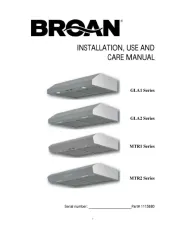
3 Juni 2025
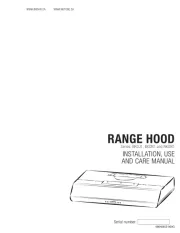
17 April 2025

17 April 2025
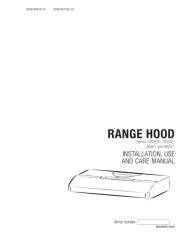
17 April 2025

17 April 2025
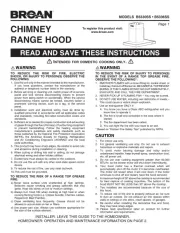
17 April 2025
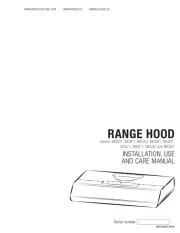
17 April 2025
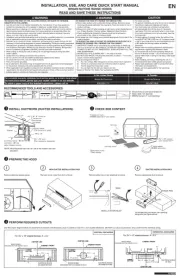
16 April 2025
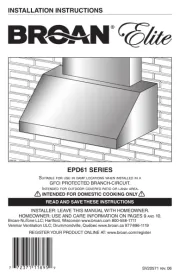
16 April 2025
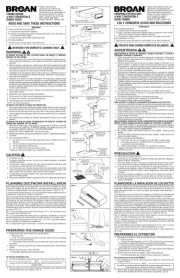
15 April 2025
Handleiding Afzuigkap
- Lofra
- Vollrath
- Viking
- Samsung
- Esatto
- Apelson
- Thermador
- Bora
- Schweigen
- AEG
- Bartscher
- CDA
- Lamona
- Arcelik
- Sauber
Nieuwste handleidingen voor Afzuigkap
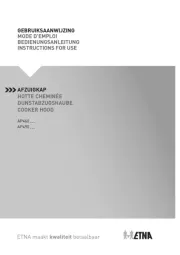
13 September 2025
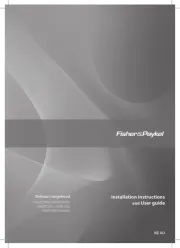
9 September 2025
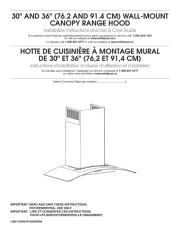
9 September 2025
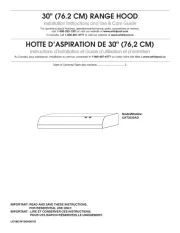
9 September 2025
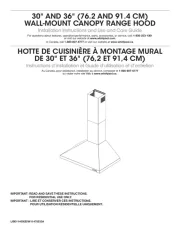
9 September 2025
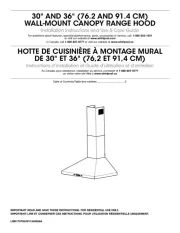
9 September 2025
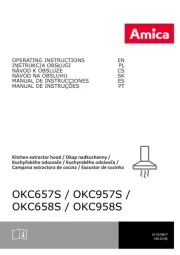
8 September 2025
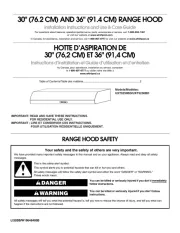
8 September 2025
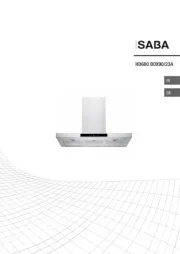
8 September 2025
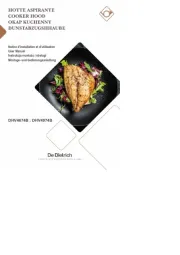
8 September 2025